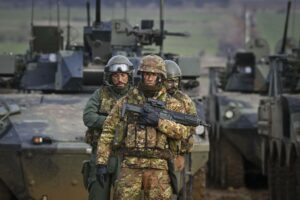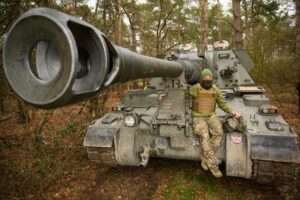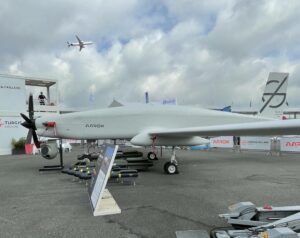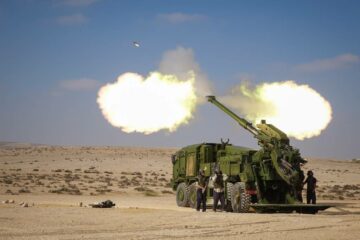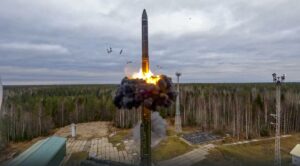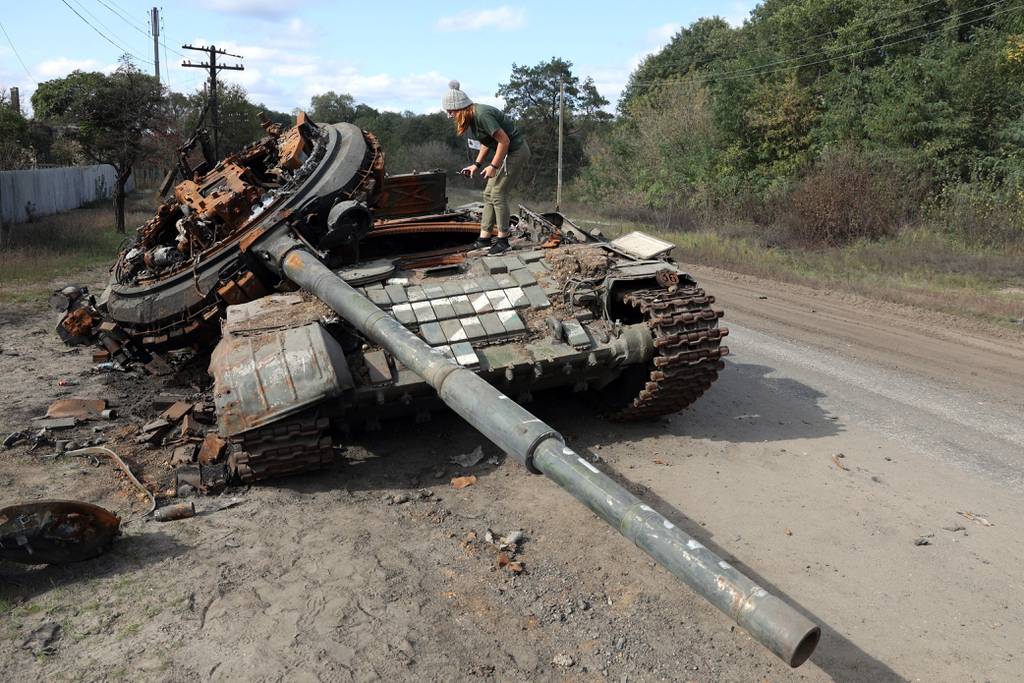
LONDON — Western companies are developing weapons aimed at cracking battle tanks from the top, their weakest point, or that can rain down thousands of metal fragments on dug-in infantry from falling drones.
The novelties come as arms manufacturers tune their lineups to the immediate experience of the brutal, close-range fighting in Ukraine, a trend on display at the DSEI defense trade show held last week in London.
Germany’s Rheinmetall, for example, is reviving a Cold War concept of bouncing mines in its proposed Area Defence Weapon. The system, which resembles a small beer keg sitting on radial stabilizers, uses a combination of sensors to verify that a tank is passing by only to launch itself into the air and drill a 155-millimeter artillery munition into the vehicle’s topside on the way down.
The company said the weapon, ready for use in a few years, could be used in combination with traditional anti-tank mines, where the ADW munition goes after mine-clearing vehicles to keep adversaries’ armored columns from advancing through mined areas.
The re-emergence of mine warfare brings to mind the situation on the frontlines of Ukraine’s defense against Russia, described in a recent Washington Post report as the world’s most mine-contaminated piece of land.
Rheinmetall, for its part, doesn’t refer to the Area Defence Weapon as a mine because the units can be turned off remotely or be programmed to let friendly forces through, with a human operator involved in the process of arming the system.
“Battlefield barriers, and anti-tank mines in particular, have been taken out of commission by NATO forces almost completely since the end of the Cold War,” a company representative explained. “The re-building of that capability is currently the subject of analyses and concepts.”
Meanwhile, Finnish company Insta is throwing its Steel Eagle shrapnel-throwing drone into the ring for meeting a Ukrainian need for killing large numbers of foot soldiers on the open battlefield with fewer scarce munitions fired as they repel Russian invaders and take back territory.
The quadcopter drone carries a fragmentation charge, which notably started its developmental life as a bouncy mine à la ADW, over infantry positions, shredding fighters with 3,000 projectiles so forceful they even penetrate thin armor, according to the company.
Steel Eagle can spray an area as large as a third of a soccer pitch with enough fragments that every square meter will get an average of one-and-a-half projectiles. The drone can also programmed to fall down to a low altitude right before exploding for a denser spray, Tuure Lehtoranta, a vice president at Insta’s defense unit, told Defense News.
Ukrainian officials have been pleading with Western allies for controversial cluster munitions that deal a similar effect, with the United States agreeing this summer to deliver some of the Pentagon’s old stocks.
According to videos circulated on social media, frontline troops have used drones to drop grenades on Russian soldiers, an effect that Lehtoranta said is too “pointed” for the kind of mass punch envisioned by Ukrainian commanders.
The company says its primary target is equipping its home forces of Finland with the Steel Eagle capability.
“There is interest not limited to Finland,” the executive said.
Sebastian Sprenger is associate editor for Europe at Defense News, reporting on the state of the defense market in the region, and on U.S.-Europe cooperation and multi-national investments in defense and global security. Previously he served as managing editor for Defense News. He is based in Cologne, Germany.
- SEO Powered Content & PR Distribution. Get Amplified Today.
- PlatoData.Network Vertical Generative Ai. Empower Yourself. Access Here.
- PlatoAiStream. Web3 Intelligence. Knowledge Amplified. Access Here.
- PlatoESG. Carbon, CleanTech, Energy, Environment, Solar, Waste Management. Access Here.
- PlatoHealth. Biotech and Clinical Trials Intelligence. Access Here.
- Source: https://www.defensenews.com/battlefield-tech/2023/09/20/ukraine-war-inspires-weapons-that-crack-battle-tanks-at-weakest-point/
- :is
- :not
- :where
- 000
- 12
- 70
- a
- According
- advancing
- After
- against
- agreeing
- aimed
- AIR
- almost
- also
- an
- and
- ARE
- AREA
- areas
- arms
- AS
- Associate
- At
- average
- back
- barriers
- based
- Battle
- Battlefield
- BE
- because
- been
- beer
- before
- Brings
- by
- CAN
- capability
- charge
- Cluster
- cold
- Cologne
- Columns
- combination
- come
- commission
- Companies
- company
- completely
- concept
- concepts
- controversial
- cooperation
- could
- crack
- cracking
- Currently
- deal
- defence
- Defense
- deliver
- described
- developing
- developmental
- Display
- Doesn’t
- down
- drone
- Drones
- Drop
- editor
- effect
- end
- enough
- Europe
- Even
- Every
- example
- executive
- experience
- explained
- Fall
- Falling
- few
- fewer
- fighters
- fighting
- Finland
- finnish
- fired
- Foot
- For
- Forces
- fragmentation
- friendly
- from
- Germany
- get
- Global
- Goes
- Have
- he
- Held
- Home
- HTTPS
- human
- images
- immediate
- in
- inspires
- insta
- interest
- into
- Investments
- involved
- ITS
- itself
- jpg
- Keep
- Kind
- Land
- large
- Last
- launch
- let
- Life
- Limited
- London
- Low
- managing
- Manufacturers
- Market
- Mass
- Media
- meeting
- metal
- mind
- mined
- mines
- most
- multi-national
- Need
- news
- notably
- numbers
- of
- off
- officials
- Old
- on
- only
- open
- operator
- or
- out
- over
- part
- particular
- Passing
- piece
- Pitch
- plato
- Plato Data Intelligence
- PlatoData
- Point
- positions
- Post
- president
- previously
- primary
- process
- programmed
- proposed
- punch
- RAIN
- ready
- recent
- refer
- region
- report
- Reporting
- representative
- resembles
- right
- Ring
- Russia
- russian
- s
- Said
- says
- Scarce
- security
- sensors
- show
- Shredding
- similar
- since
- Sitting
- situation
- small
- So
- Soccer
- Social
- social media
- some
- square
- started
- State
- States
- steel
- Stocks
- subject
- summer
- system
- Take
- taken
- tank
- Tanks
- Target
- territory
- that
- The
- The Area
- The State
- their
- they
- Third
- this
- thousands
- Through
- Throwing
- to
- told
- too
- top
- trade
- traditional
- Trend
- Turned
- Ukraine
- ukraine war
- Ukraines
- Ukrainian
- unit
- United
- United States
- units
- use
- used
- uses
- Vehicles
- verify
- vice
- Vice President
- Videos
- war
- washington
- washington post
- Way..
- Weapons
- week
- Western
- which
- will
- with
- world’s
- years
- zephyrnet


